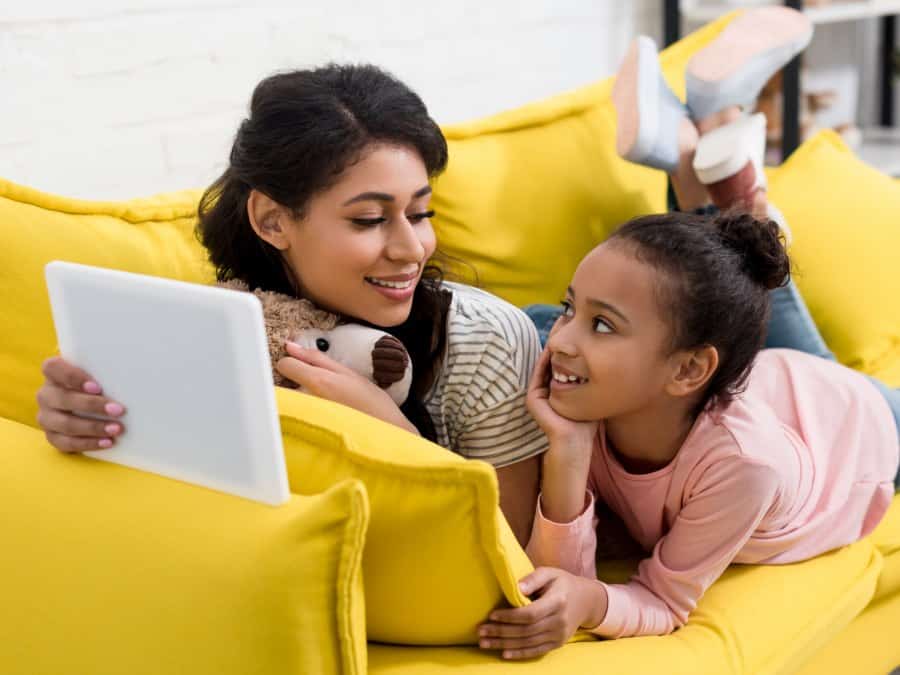
Above: Monitored and shared screen time is considered best practice for younger children. Photo by Vitalik Radko/DepositPhotos.
BitDepth#1176 for December 20, 2018
In her book The Art of Screentime, hopefully subtitled “How Your Family Can Balance Digital Media and Real Life,” National Public Radio journalist Anya Kamenetz grapples from the perspective of a mother and an enthusiastic user with the pervasiveness of screens in the lives of today’s children from multiple perspectives.
I was drawn to the book through my own experience over the last five years with a child who, like almost all children today, is growing up surrounded by screens and more compellingly, by adults who now use them continuously.
As I write this, I am all too aware that I’m doing so on a laptop screen, one that’s bracketed on either side by massive image editing monitors, which have been my default working environment for most of the life of a small child.
So “stop looking at that screen” begins to ring a bit hollow when the adults who are supposed to give direction are continuously bathed in the glow of LCD monitors.
Kamenetz quotes Professor Eric E Rasmussen, a Texas Tech academic who researches the media’s impact on children, “To understand how the world works, they need to see how the world works.”
That’s a perspective that’s governed some of my own thinking over 62 months of almost continuous adjustment and recalibration on screen access and limits, failing most gloriously at setting an example that lives up to my own portentous warnings.
But talking loftily about limiting screen time also comes from a position of privilege, as Kamenetz points out in her book. It presumes that a parent can provide a healthy alternative.
If the choices are watching television and going to a playground known for drive-by shootings, then there’s really no choice at all, is there?
Kamenetz cites disturbing numbers for US screen consumption, running to four hours a day for very young children and six to seven hours a day for older children.
Much of the current understanding on the impact of screentime is on harm reduction, ways to manage what is seen and for how long, while balancing the potential for learning with real world experiences.
What’s on the screen is also critically important.
Video games are designed to be addictive, and the most successful among them trigger rushes of cortisol and dopamine, a feel-good hormone to the brain that adapts to crave more, according to a Psychology Today paper.
“Every child is different,” Kamenetz writes, “there is no established safe or toxic dose.”
Add to that mix the different responses that are associated with age, background and environment and the screentime prescription for each child becomes one that’s tailored to specific content, experiences and responses. That demands observation and clarity about how devices are being used.
Don’t even assume that an app labeled as educational actually is. Kamenetz urges parents to cross-examine software. Be clear about the purpose of the app, she warns. Examine the pedagogy that underlies the app and what new knowledge it is purporting to transfer.
But this isn’t a recipe for drone parenting (the new version of helicoptering). The critical learning from engagements with screen time are about teaching a child to set their own limits, intervening with mediation but restraint when things go off the rails.
“Trust, verify and respect their privacy,” Kamenetz suggests.
Eric Rasmussen’s advice to parents via Brigham Young University…
• As a parent, change your own media habits to reflect what you want your child’s habits to be.
• Talk about the media. Share your opinion. Don’t leave any doubt about where you stand, but also value your children’s thoughts and opinions.
• Establish media rules right away, and provide reasons for the rules.
• Watch media with your children.
• Bring the TV and computers out of bedrooms and into a shared family space.
• Don’t allow phones in the bedroom at or after bedtime. This goes for parents too.
• Be friends with and follow your kids on social media.
• Have the usernames and passwords to all your child’s accounts.



